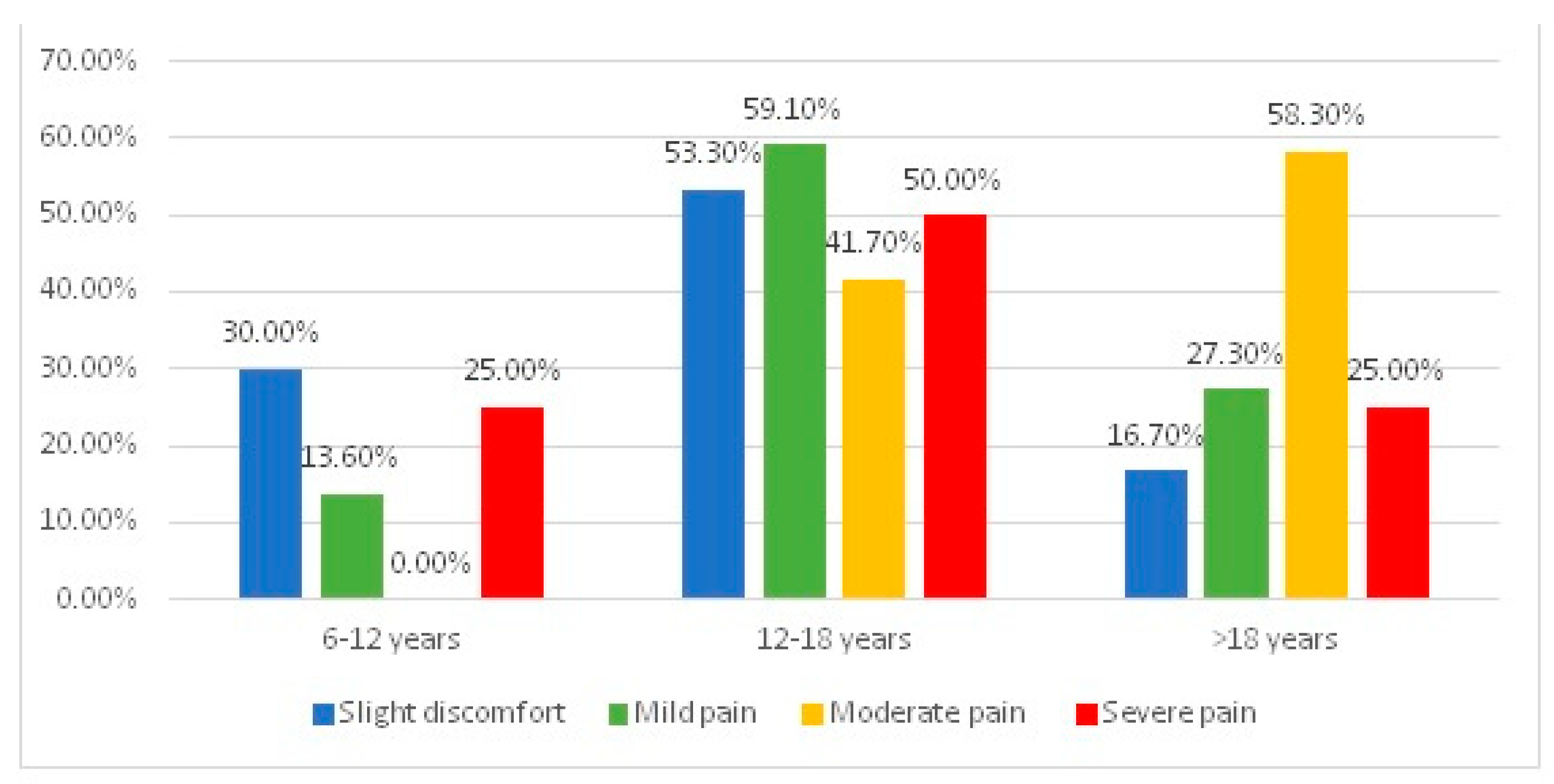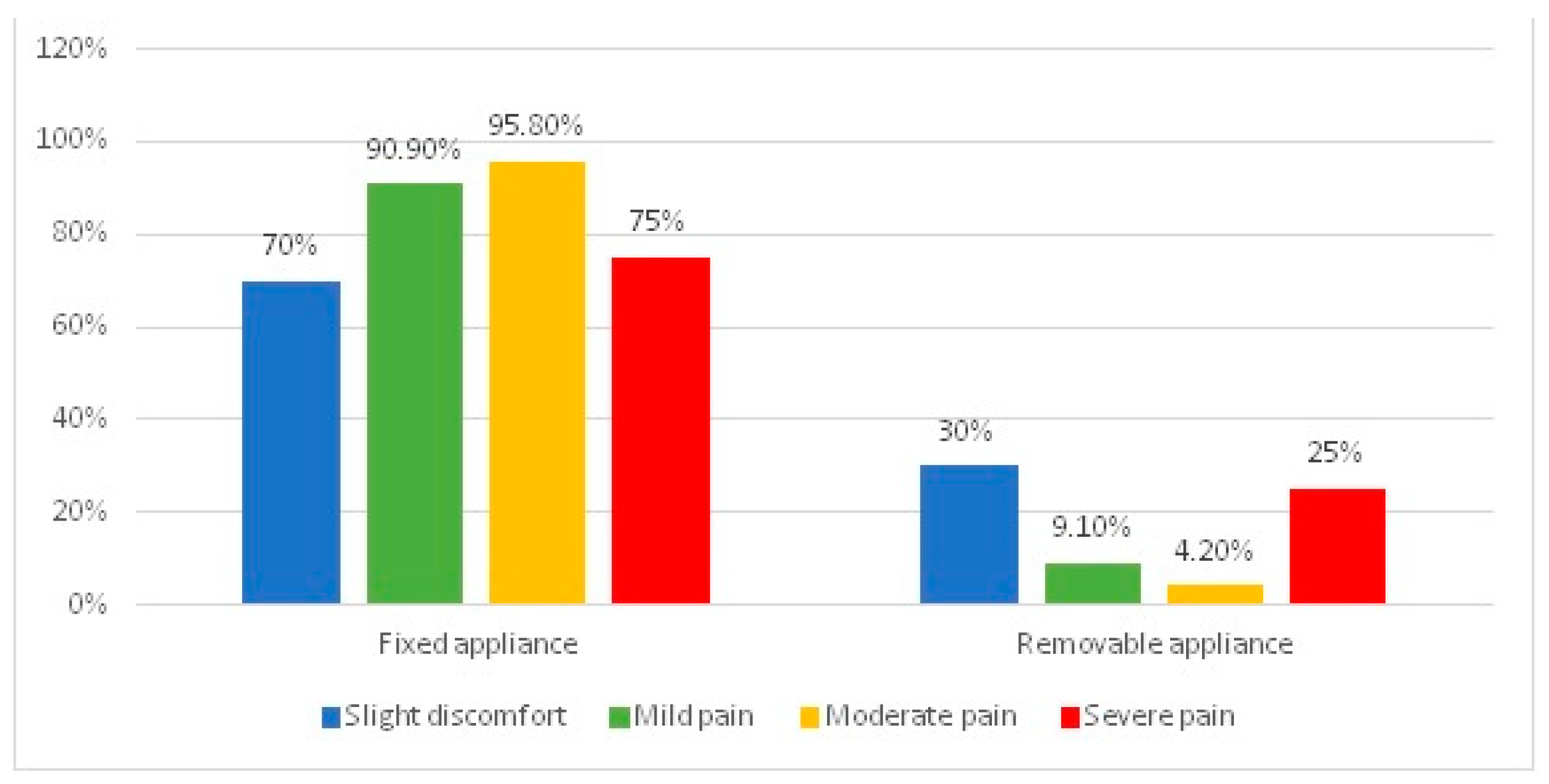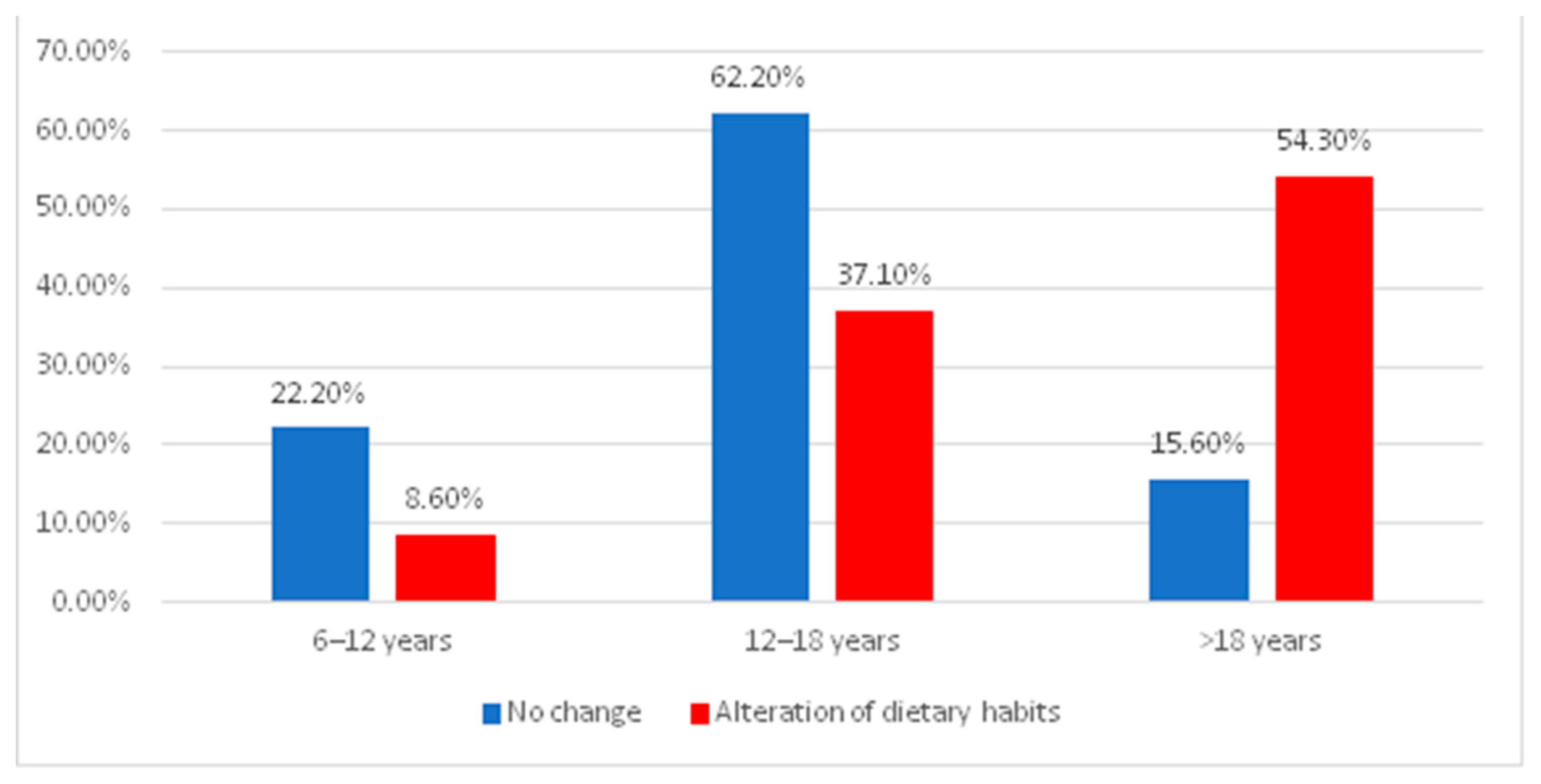Orthodontic Pain and Dietary Impact Considering Age Groups: A Comparative Study
Abstract
1. Introduction
2. Materials and Methods
2.1. Sample Selection
2.2. Statistical Analysis
2.3. Ethical Considerations
3. Results
4. Discussion
5. Conclusions
Author Contributions
Funding
Institutional Review Board Statement
Informed Consent Statement
Data Availability Statement
Conflicts of Interest
References
- O’Connor, P.J. Patients’ perceptions before, during, and after orthodontic treatment. J. Clin. Orthod. 2000, 34, 591–592. [Google Scholar] [PubMed]
- Bartlett, B.W.; Firestone, A.R.; Vig, K.W.; Beck, F.M.; Marucha, P.T. The influence of a structured telephone call on orthodontic pain and anxiety. Am. J. Orthod. Dentofac. Orthop. 2005, 128, 435–441. [Google Scholar] [CrossRef] [PubMed]
- Shalchi, M.; Mahdavi Roshan, M.; Imani, M.M.; Aghajani, R.; Khabbaz, S.; Shafiei Haghshenas, E. Evaluation of Pain, Dietary Intake, Body Mass Index, and Periodontal Status in Patients Undergoing Fixed Orthodontic Treatment With Bite Raiser. Cureus 2022, 14, e32800. [Google Scholar] [CrossRef] [PubMed]
- Vaida, L.; Todor, B.I.; Bertossi, D.; Corega, C. Correlations between Stress, Anxiety and Coping Mechanisms in Orthodontic Patients. Iran. J. Public Health 2015, 44, 147–149. [Google Scholar] [PubMed]
- Keim, R.G. Managing orthodontic pain. J. Clin. Orthod. 2004, 38, 641–642. [Google Scholar]
- Shirazi, A.S.; Mobarhan, M.G.; Nik, E.; Kerayechian, N.; Ferns, G.A. Comparison of dietary intake between fixed orthodontic patients and control subjects. Aust. Orthod. J. 2011, 27, 17–22. [Google Scholar] [CrossRef]
- Tapeshkina, M.M.; Kostritsin, A.G.; Tapeshkina, N.V.; Chernenko, S.V. Osobennosti pitaniya detei pri ortodonticheskom lechenii zubochelyustnykh anomalii breket-sistemami [Nutrition of children undergoing orthodontic treatment with fixed appliances]. Stomatologiia 2020, 99, 74–77. (In Russian) [Google Scholar] [CrossRef]
- Riordan, D.J. Effects of orthodontic treatment on nutrient intake. Am. J. Orthod. Dentofac. Orthop. 1997, 111, 554–561. [Google Scholar] [CrossRef]
- Abed Al Jawad, F.; Cunningham, S.J.; Croft, N.; Johal, A. A qualitative study of the early effects of fixed orthodontic treatment on dietary intake and behaviour in adolescent patients. Eur. J. Orthod. 2012, 34, 432–436. [Google Scholar] [CrossRef]
- Sandeep, K.S.; Singaraju, G.S.; Reddy, V.K.; Mandava, P.; Bhavikati, V.N.; Reddy, R. Evaluation of body weight, body mass index and body fat percentage changes in early stages of fixed orthodontic therapy. J. Int. Socienty Prev. Community Dent. 2016, 6, 349. [Google Scholar]
- Firestone, A.R.; Scheurer, P.A.; Bürgin, W.B. Patients’ anticipation of pain and pain-related side effects, and their perception of pain as a result of orthodontic treatment with fixed appliances. Eur. J. Orthod. 1999, 21, 387–396. [Google Scholar] [CrossRef]
- Bergius, M.; Kiliaridis, S.; Berggren, U. Pain in orthodontics. A review and discussion of the literature. J. Orofac. Orthop. 2000, 61, 125–137. [Google Scholar] [CrossRef]
- Krishnan, V. Orthodontic pain from causes to management—A review. Eur. J. Orthod. 2007, 29, 170–179. [Google Scholar] [CrossRef]
- Johal, A.; Fleming, P.; Al Jawad, F.A. A prospective longitudinal controlled assessment of pain experience and oral health-related quality of life in adolescents undergoing fixed appliance treatment. Orthod. Craniofac. Res. 2014, 17, 178–186. [Google Scholar] [CrossRef]
- Feldmann, I.; List, T.; Bondemark, L. Orthodontic anchoring techniques and its influence on pain, discomfort and jaw function—A randomized controlled trial. Eur. J. Orthod. 2011, 34, 102–108. [Google Scholar] [CrossRef]
- Vaida, L.; Corega, C.; Roseanu, G. Researches regarding current self-related cognitions in patients with orthodontic treatment. J. Cogn. Behav. Psychoter. 2009, 9, 131–133. [Google Scholar]
- Godinho, J.; Peres Goncalves, R.; Jardim, L. Contribution of facial components to the attractiveness of the smiling face in male and female patients: A cross-sectional correlation study. Am. J. Orthod. Dentofac. Orthop. 2020, 157, 98–104. [Google Scholar] [CrossRef]
- Baseer, M.A.; Almayah, N.A.; Alqahtani, K.M.; Alshaye, M.I.; Aldhahri, M.M. Oral Impacts Experienced by Orthodontic Patients Undergoing Fixed or Removable Appliances Therapy in Saudi Arabia: A Cross-Sectional Study. Patient Prefer. Adherence 2021, 15, 2683–2691. [Google Scholar] [CrossRef] [PubMed]
- Sultan, H.; Pervez, H.; Maqsood, S.; Zeeshan, W.S. Evaluation of pain experienced by orthodontic patients following elastomeric separator insertion: A cross-sectional study. Korean J. Orthod. 2023, 53, 298–306. [Google Scholar] [CrossRef] [PubMed]
- Scott, P.; Sherriff, M.; Dibiase, A.T.; Cobourne, M.T. Perception of discomfort during initial orthodontic tooth alignment using a self-ligating or conventional bracket system: A randomized clinical trial. Eur. J. Orthod. 2008, 30, 227–232. [Google Scholar] [CrossRef] [PubMed]
- Jones, M.L. An investigation into the initial discomfort caused by placement of an archwire. Eur. J. Orthod. 1984, 6, 48–54. [Google Scholar] [CrossRef]
- e Leeuw, R.; Albuquerque, R.J.C.; Andersen, A.H.; Carlson, C.R. Influence of estrogen on brain activation during stimulation with painful heat. J. Oral. Maxillofac. Surg. 2006, 64, 158–166. [Google Scholar] [CrossRef] [PubMed]
- Myers, C.D.; Tsao, J.C.I.; Glover, D.A.; Kim, S.C.; Turk, N.; Zeltzer, L.K. Sex, gender, and age: Contributions to laboratory pain responding in children and adolescents. J. Pain 2006, 7, 556–564. [Google Scholar] [CrossRef]
- Rakhshan, H.; Rakhshan, V. Pain and discomfort perceived during the initial stage of active fixed orthodontic treatment. Saudi Dent. J. 2015, 27, 81–87. [Google Scholar] [CrossRef] [PubMed]
- Wiedel, A.P.; Bondemark, L. A randomized controlled trial of self-perceived pain, discomfort, and impairment of jaw function in children undergoing orthodontic treatment with fixed or removable appliances. Angle Orthod. 2015, 86, 324–330. [Google Scholar] [CrossRef] [PubMed]
- Alajmi, S.; Shaban, A.; Al-Azemi, R. Comparison of short-term oral impacts experienced by patients treated with Invisalign or conventional fixed orthodontic appliances. Med. Princ. Pract. 2020, 29, 382–388. [Google Scholar] [CrossRef] [PubMed]
- Soltis, J.E.; Nakfoor, P.R.; Bowman, D.C. Changes in ability of patients to differentiate intensity of forces applied to maxillary central incisors during orthodontic treatment. J. Dent. Res. 1971, 50, 590–596. [Google Scholar] [CrossRef]
- Burstone, C.J.; Kraus, B.S.; Riedel, R.A. The Biomechanics of Tooth Movement, Vistas in Orthodontics; Lea & Febiger: Philadelphia, PA, USA, 1962; pp. 197–213. [Google Scholar]
- Polat, O.; Karaman, A.I.; Durmus, E. Effects of preoperative ibuprofen and naproxen sodium on orthodontic pain. Angle Orthod. 2005, 75, 791–796, Erratum in Angle Orthod. 2008, 78, 798. [Google Scholar]
- Johal, A.; Abed Al Jawad, F.; Marcenes, W.; Croft, N. Does orthodontic treatment harm children’s diets? J. Dent. 2013, 41, 949–954. [Google Scholar] [CrossRef]
- Ozdemir, M.; Ilhan, A.; Gorucu-Coskuner, H.; Taner, T.; Bilgic, P. Assessment of food consumption changes in adolescents during orthodontic treatment. Am. J. Orthod. Dentofac. Orthop. 2021, 159, 604–612. [Google Scholar] [CrossRef]
- Shalish, M.; Cooper-Kazaz, R.; Ivgi, I.; Canetti, L.; Tsur, B.; Bachar, E.; Chaushu, S. Adult patients’ adjustability to orthodontic appliances. Part I: A comparison between Labial, Lingual, and InvisalignTM. Eur. J. Orthod. 2012, 34, 724–730. [Google Scholar] [CrossRef] [PubMed]
- Ajwa, N.; Makhdoum, L.; Alkhateeb, H.; Alsaadoun, A.; Alqutub, S.; Alkhumayes, H. The impact of orthodontic appliance on body weight changes, dietary habits, and self-perceived discomfort in early stages of orthodontic treatment. Glob. J. Health Sci. 2018, 10, 11–17. [Google Scholar] [CrossRef][Green Version]
- Soni, V.K.; Sharma, L.; Patel, P. Comparative evaluation of changes observed in the weights of patients undergoing fixed orthodontic treatment in Jaipur population. Int. J. Pharm. Sci. Invent. 2013, 2, 66–69. [Google Scholar]
- Aljohani, S.R.; Alsaggaf, D.H. Adherence to Dietary Advice and Oral Hygiene Practices Among Orthodontic Patients. Patient Prefer. Adherence 2020, 14, 1991–2000. [Google Scholar] [CrossRef] [PubMed]



| Age Category/Gender | Female | Male | p * | ||
|---|---|---|---|---|---|
| No. | % | No. | % | ||
| 6–12 years | 18 | 15% | 8 | 20% | 0.002 0.007, R = −0.223 ** |
| 12–18 years | 54 | 45% | 28 | 70% | |
| >18 years | 48 | 40% | 4 | 10% | |
| Age Category/Pain Latency | No Pain | 5 Min | Few Hours | 1 Day | 1 Week | p * | |||||
|---|---|---|---|---|---|---|---|---|---|---|---|
| Nr. | % | Nr. | % | Nr. | % | Nr. | % | Nr. | % | ||
| 6–12 years | 4 | 28.6% | 14 | 41.2% | 8 | 12.5% | 0 | 0% | 0 | 0% | <0.001 <0.001, R = 0.564 ** |
| 12–18 years | 10 | 71.4% | 20 | 58.8% | 36 | 58.2% | 16 | 34.8% | 0 | 0% | |
| >18 years | 0 | 0% | 0 | 0% | 20 | 31.2% | 30 | 65.2% | 2 | 100% | |
| Age Category/Weight Loss | No Weight Loss | With Weight Loss | p * | ||
|---|---|---|---|---|---|
| No. | % | No. | % | ||
| 6–12 years | 24 | 21.4% | 2 | 4.2% | 0.001 <0.001, R= 0.285 ** |
| 12–18 years | 60 | 53.6% | 22 | 45.8% | |
| >18 years | 28 | 25% | 24 | 50% | |
Disclaimer/Publisher’s Note: The statements, opinions and data contained in all publications are solely those of the individual author(s) and contributor(s) and not of MDPI and/or the editor(s). MDPI and/or the editor(s) disclaim responsibility for any injury to people or property resulting from any ideas, methods, instructions or products referred to in the content. |
© 2024 by the authors. Licensee MDPI, Basel, Switzerland. This article is an open access article distributed under the terms and conditions of the Creative Commons Attribution (CC BY) license (https://creativecommons.org/licenses/by/4.0/).
Share and Cite
Negruțiu, B.-M.; Vaida, L.L.; Judea-Pusta, C.; Romanec, C.; Moca, A.E.; Costea, C.P.; Staniș, C.-E.; Rus, M. Orthodontic Pain and Dietary Impact Considering Age Groups: A Comparative Study. J. Clin. Med. 2024, 13, 1069. https://doi.org/10.3390/jcm13041069
Negruțiu B-M, Vaida LL, Judea-Pusta C, Romanec C, Moca AE, Costea CP, Staniș C-E, Rus M. Orthodontic Pain and Dietary Impact Considering Age Groups: A Comparative Study. Journal of Clinical Medicine. 2024; 13(4):1069. https://doi.org/10.3390/jcm13041069
Chicago/Turabian StyleNegruțiu, Bianca-Maria, Luminița Ligia Vaida, Claudia Judea-Pusta, Cristian Romanec, Abel Emanuel Moca, Cristina Paula Costea, Claudia-Elena Staniș, and Marius Rus. 2024. "Orthodontic Pain and Dietary Impact Considering Age Groups: A Comparative Study" Journal of Clinical Medicine 13, no. 4: 1069. https://doi.org/10.3390/jcm13041069
APA StyleNegruțiu, B.-M., Vaida, L. L., Judea-Pusta, C., Romanec, C., Moca, A. E., Costea, C. P., Staniș, C.-E., & Rus, M. (2024). Orthodontic Pain and Dietary Impact Considering Age Groups: A Comparative Study. Journal of Clinical Medicine, 13(4), 1069. https://doi.org/10.3390/jcm13041069








